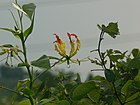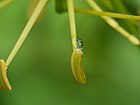Note: This is a project under development. The articles on this wiki are just being initiated and broadly incomplete. You can Help creating new pages.
Gloriosa superba - Flame lily, Agnimukhi
Agnimukhi is a genus of 12 species in the plant family Colchicaceae and include the formerly recognised genus Littonia. They are native in tropical and southern Africa to Asia and naturalised in Australia and the Pacific as well as being widely cultivated.
Contents
- 1 Uses
- 2 Parts Used
- 3 Chemical Composition
- 4 Common names
- 5 Properties
- 6 Habit
- 7 Identification
- 8 List of Ayurvedic medicine in which the herb is used
- 9 Where to get the saplings
- 10 Mode of Propagation
- 11 How to plant/cultivate
- 12 Commonly seen growing in areas
- 13 Photo Gallery
- 14 References
- 15 External Links
Uses
Arthritis, Gout, Rheumatism, Inflammation, Ulcer, Skin diseases, Leprosy, Snake bite, Gonorrhoea, Purgative, Itching, Infertility, Abdominal pain.
Parts Used
Chemical Composition
Seed contain high level of colchicines. Cornigerine, 3-demethyl-N-formyl-N-deacetyl-b-lumicolchicine, 3-demethyl-g-lumicolchicine, 3-demethyl colchicines have been isolated from plant. b-sitosterol[1]
Common names
| Language | Common name |
|---|---|
| Kannada | Agnisikhe, Karadikanninagadde |
| Hindi | Bachnag, Kadyanag |
| Malayalam | Kithonni, Mendoni |
| Tamil | Kallappai kilangu |
| Telugu | Agnisikha |
| Marathi | NA |
| Gujarathi | NA |
| Punjabi | NA |
| Kashmiri | NA |
| Sanskrit | Agnimukhi |
| English | Glory Lily, Gloriosa lily |
Properties
Reference: Dravya - Substance, Rasa - Taste, Guna - Qualities, Veerya - Potency, Vipaka - Post-digesion effect, Karma - Pharmacological activity, Prabhava - Therepeutics.
Dravya
Rasa
Tikta (Bitter), Katu (Pungent)
Guna
Laghu (Light), Ruksha (Dry), Tikshna (Sharp)
Veerya
Ushna (Hot)
Vipaka
Katu (Pungent)
Karma
Kapha, Vata
Prabhava
Habit
Identification
Leaf
| Kind | Shape | Feature |
|---|---|---|
| Simple | 4-25 cm long and 1.5-4.5 cm wide | The leaves are alternately arranged along the stems, stalkless (i.e. sessile), and have entire margins |
Flower
| Type | Size | Color and composition | Stamen | More information |
|---|---|---|---|---|
| Unisexual | 2-4cm long | Yellow | 6 | large and showy |
Fruit
| Type | Size | Mass | Appearance | Seeds | More information |
|---|---|---|---|---|---|
| large, fleshy | 3-10 cm long and 1-2 cm wide | turn from green to yellow and eventually dark brown as they mature | These fruit contain numerous large red seeds | single | {{{6}}} |
Other features
List of Ayurvedic medicine in which the herb is used
- Vishatinduka Taila as root juice extract
Where to get the saplings
Mode of Propagation
How to plant/cultivate
A plant of the lowland tropics and subtropics, where it can be found at elevations up to 600 metres, the plant has a clear preference for seasonal, monsoon climates with a pronounced dry season[3]
Commonly seen growing in areas
Tropical area, Subtropical area, Warmer temperate region.
Photo Gallery
References
External Links
- Ayurvedic Herbs known to be helpful to treat Arthritis
- Ayurvedic Herbs known to be helpful to treat Gout
- Ayurvedic Herbs known to be helpful to treat Rheumatism
- Ayurvedic Herbs known to be helpful to treat Inflammation
- Ayurvedic Herbs known to be helpful to treat Ulcer
- Ayurvedic Herbs known to be helpful to treat Skin diseases
- Ayurvedic Herbs known to be helpful to treat Leprosy
- Ayurvedic Herbs known to be helpful to treat Snake bite
- Ayurvedic Herbs known to be helpful to treat Gonorrhoea
- Ayurvedic Herbs known to be helpful to treat Purgative
- Ayurvedic Herbs known to be helpful to treat Itching
- Ayurvedic Herbs known to be helpful to treat Infertility
- Ayurvedic Herbs known to be helpful to treat Abdominal pain
- Herbs with Flowers used in medicine
- Herbs with Fruits used in medicine
- Herbs with common name in Kannada
- Herbs with common name in Hindi
- Herbs with common name in Malayalam
- Herbs with common name in Tamil
- Herbs with common name in Telugu
- Herbs with common name in Sanskrit
- Herbs with common name in English
- Habit - Climber
- Index of Plants which can be propagated by Seeds
- Index of Plants which can be propagated by Cuttings
- Herbs that are commonly seen in the region of Tropical area
- Herbs that are commonly seen in the region of Subtropical area
- Herbs that are commonly seen in the region of Warmer temperate region
- Herbs









